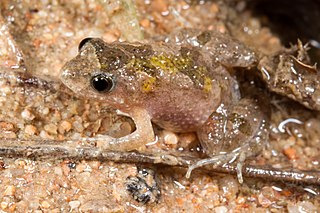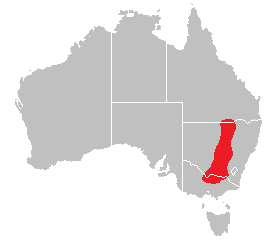
The common eastern froglet is a very common, Australian ground-dwelling frog, of the family Myobatrachidae.

The Tasmanian froglet is a species of ground-dwelling frog that occurs only in Tasmania, Australia.
The streambank froglet or Flinders Ranges froglet is a small, locally common, Australian ground-dwelling frog, of the family Myobatrachidae.
The Cameroon soft-furred mouse or Cameroon praomys is a species of rodent in the family Muridae. It is found in Cameroon and Equatorial Guinea. Its natural habitat is subtropical or tropical moist montane forests. It is threatened by habitat loss.

The bilingual frog is a species of frog in the family Myobatrachidae. It is endemic to Australia. Its natural habitats are moist savanna, intermittent rivers, and swamps.

The desert froglet is a species of frog in the family Myobatrachidae, endemic to Australia. The species is not under any threat of extinction. Desert froglets occur mainly in dry or moist savanna habitats, principally from the mid-western border of Northern Territory, south-east into western Queensland and New South Wales and the north-east corner of South Australia. They can also be found along the Queensland coast where it has been recorded between Townsville and Cooktown, and as far south as Hervey Bay.

The quacking frog also known as the red-thighed froglet is a species of frog in the family Myobatrachidae. It is endemic to Australia. Its call has been described as closely resembling the quack of a duck.
Glauert's froglet is a species of frog in the family Myobatrachidae. It is endemic to Australia. Its natural habitats are temperate forests, rivers, intermittent rivers, shrub-dominated wetlands, swamps, freshwater lakes, freshwater marshes, arable land, pastureland, plantations, rural gardens, water storage areas, ponds, open excavations, sewage treatment areas, and introduced vegetation. It is threatened by habitat loss.
The moss froglet, or moss frog, is a species of frog in the family Myobatrachidae. It is endemic to Tasmania. Its natural habitats are subtropical or tropical moist lowland forests, temperate shrubland, and swamps.
The false western froglet is a species of frog in the family Myobatrachidae. It is endemic to Australia. Its natural habitats are temperate forests, rivers, intermittent rivers, shrub-dominated wetlands, swamps, freshwater lakes, intermittent freshwater lakes, freshwater marshes, intermittent freshwater marshes, freshwater springs, rocky areas, arable land, pastureland, plantations, water storage areas, ponds, open excavations, wastewater treatment areas, seasonally flooded agricultural land, and canals and ditches. It is threatened by habitat loss.
The remote froglet is a species of frog in the family Myobatrachidae. It is found in Australia and New Guinea. Its natural habitats are moist savanna, subtropical or tropical dry lowland grassland, subtropical or tropical seasonally wet or flooded lowland grassland, swamps, freshwater lakes, freshwater marshes, intermittent freshwater marshes, coastal freshwater lagoons, and canals and ditches.

Sloane's froglet is a species of frog in the family Myobatrachidae. It is endemic to Australia. Its natural habitats are subtropical or tropical seasonally wet or flooded lowland grassland and intermittent freshwater marshes in and around the floodplains of the Murray-Darling Basin
The small western froglet is a species of frog in the family Myobatrachidae. It is endemic to Australia. Its natural habitats are temperate forests, subtropical or tropical seasonally wet or flooded lowland grassland, swamps, freshwater lakes, intermittent freshwater lakes, freshwater marshes, and intermittent freshwater marshes. It is threatened by habitat loss.
Geocrinia rosea, the karri or roseate frog is a species in the family, Myobatrachidae. It is endemic to Southwest Australia.
The Kern Plateau salamander is a species of salamander in the family Plethodontidae, endemic to California, in Tulare and Inyo, and Kern Counties in the western United States.

Ctenosaura oaxacana, commonly known as the Oaxacan spiny-tailed iguana, is a species of lizard in the family Iguanidae. It is endemic to Mexico.

The gracile naked-tailed shrew is a species of mammal in the family Soricidae. It is found in Burundi, Gabon, Kenya, and Uganda. Its natural habitat is swamps.

The Ugandan lowland shrew is a species of mammal in the family Soricidae. It is found in Kenya and Uganda. Its natural habitats are subtropical or tropical swamps and subtropical or tropical moist montane forest. It is threatened by habitat loss.

Babault's mouse shrew is a species of mammal in the family Soricidae found in Burundi, the Democratic Republic of the Congo, and Uganda. Its natural habitat is subtropical or tropical moist montane forests. It is threatened by habitat loss.

The Mount Cameroon forest shrew is a species of mammal in the family Soricidae endemic to Cameroon. Its natural habitat is subtropical or tropical moist montane forests.











